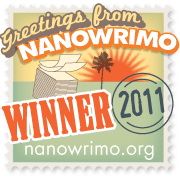This year, two people I know have lost everything they were working on due to computer problems. A. lost her PhD when her netbook decided to pack it in, and G. lost all his writing projects when burglars nicked his laptop. It made me very grateful that I’ve been storing all my writing – including Scrivener product files – on Dropbox since last year. I’m getting network storage for home to back up and archive to but that won’t keep me entirely safe: last year, H. lost a bunch of things she was working on when her server died. She was lucky: it could be retrieved so it was a temporary loss.
So far, my strategy has simply been to store everything on Dropbox. That way, I have access from my desktop and laptop, and from anywhere else (other people’s computers, usually). Cloud storage solutions break, though, not often, but they do. Hence my plan for local network storage. A germ of paranoia has taken root in me so I think I will also store printed copies of finished stories. It feels sensible to have hard as well as soft copies. Hard copies are surprisingly resilient: I have a whole arch file full of stories I wrote as a teenager, and I recently read a story a friend of mine photocopied and mailed to me since only the printout remained.
Digital is not generally viewed as a suitable long-term preservation archival surrogate for print. It is currently regarded more as an access medium.
Digital versus print as a preservation format – expert views from international comparator libraries, British Library
Everything I write starts its life in digital format, either as a bunch of ideas and notes in Evernote, Scrivener drafts in Dropbox, or even notes on my phone. I use paper, but a lot of what I write on paper I either throw away or transcribe. I’ve been writing using digital means since I was 17 when I kept a Pascal diary in Computer Science instead of paying attention at lessons. Those early oeuvres are no longer available to me. They are stored on media that haven’t been used for years. Never mind 5.25″ floppies – none of my current computers have a 3.5″ floppy drive so I can’t read the many disks I so carefully filled and labelled at university and the first few years that I worked. It’s not a big deal: there’s nothing there I need, or want, particularly. But it makes me aware that the stories I write today might be difficult to access in 10 or 20 years’ time.
Technology changes. So although I use digital means of production, I’m going to take a leaf from the British Library’s book and start storing paper.
